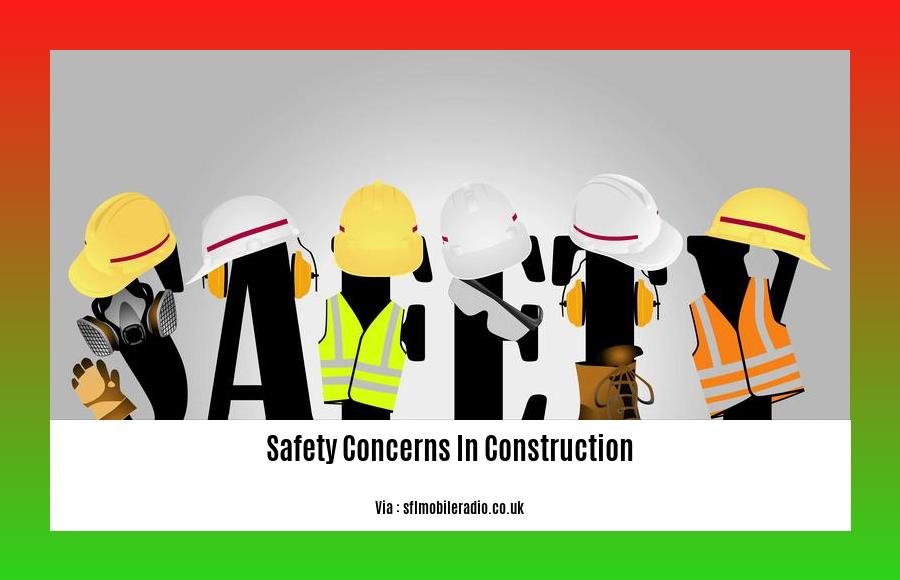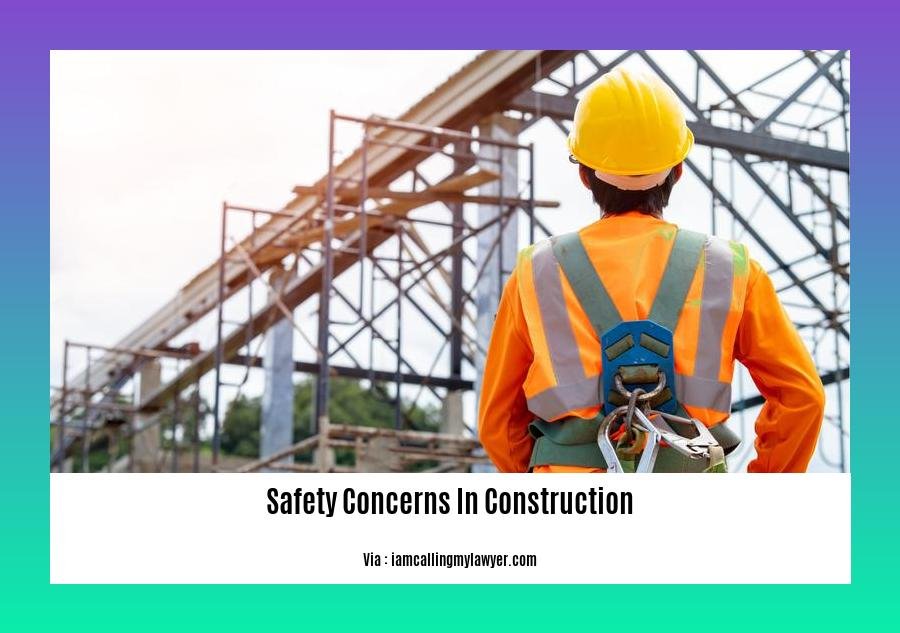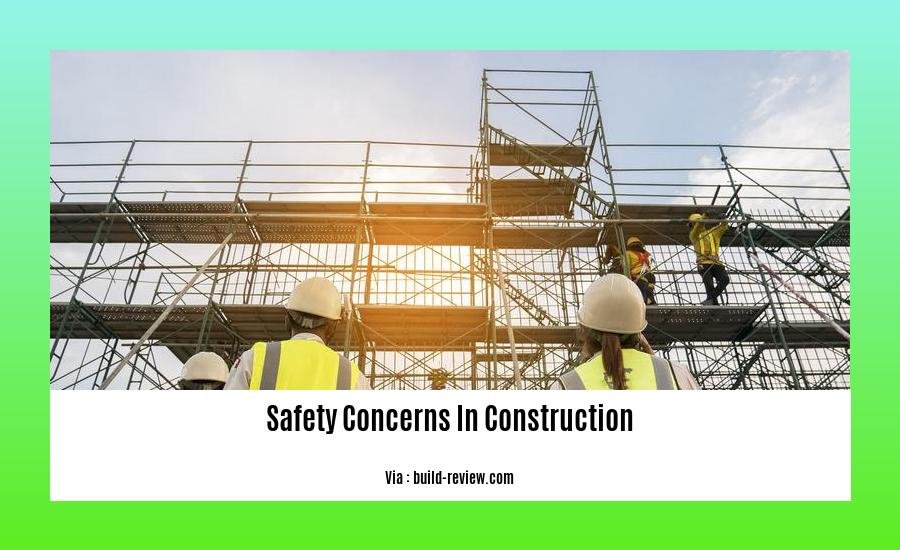In the realm of construction, the paramount concern is the safety and well-being of its workforce. [- Addressing Safety Concerns in Construction: A Comprehensive Analysis] delves into the pressing issues and challenges that plague this industry, exploring the root causes of accidents, examining current safety protocols, and proposing innovative solutions to enhance worker protection.
Key Takeaways
- Suicides are a major concern in construction due to mental health issues.
- Exhaustion is common and can lead to safety incidents.
- Work from heights is dangerous and a leading cause of fatalities and severe injury.
- Collissions can be serious and often result from improper vehicle and equipment use.
- Slippery and uneven workspaces cause as many as 70% of non-fatal site incidents.
- Extended exposure to heavy construction equipment can induce lifelong hearing loss.
- The prolonged use of hand-vibrated tools can cause severe and long-lasting damage.
- Lifting materials without proper techniques can cause back, neck, and shoulder issues.
Safety Concerns in Construction

Recognizing safety concerns in construction and taking proactive measures to mitigate risks is paramount for the well-being of workers and the success of any project. Here are some critical steps to address these challenges:
Evaluate and Identify Hazards
A comprehensive risk assessment is vital to pinpoint potential safety concerns in construction. This includes identifying hazards such as working at heights, electrical hazards, exposure to hazardous substances, and ergonomic risks. Regular inspections and monitoring help keep risks under control.
Enforce Safety Protocols and Training
Establish clear safety protocols and ensure all workers are trained on them. This includes proper use of personal protective equipment (PPE), following work procedures, and reporting hazards. Training should be ongoing and emphasize hands-on scenarios.
Foster a Safety Culture
Promote a safety-conscious culture where workers are encouraged to identify and report safety concerns in construction. Encourage open communication and empower workers to stop work if they feel unsafe.
Prioritize Incident Reporting and Investigation
All incidents, near misses, and hazardous conditions should be promptly reported and investigated. Determine root causes and implement corrective measures to prevent reoccurrences.
Collaborate and Seek Expertise
Seek advice from safety professionals, industry experts, and regulatory agencies. Stay updated on best practices, new technologies, and industry regulations to continuously improve safety measures.
Embrace Technology
Utilize wearable devices, sensors, and digital platforms to monitor safety hazards, track training compliance, and enhance communication. Technology can help identify and mitigate risks in real-time.
Empower Workers
Engage workers in the safety process. Encourage feedback, suggestions, and active participation in hazard identification and control. Empowered workers are more likely to adhere to safety protocols and contribute to a safer workplace.
For more information about the responsibility of safety officers in construction sites, safety boards for construction sites, safety equipment lists for construction, and safety gear for construction workers, please visit our website.
Educating Workers on Safety Protocols

Despite advancements in the construction industry, safety remains a critical concern, with a high incidence of work-related injuries and fatalities. Educating Workers on Safety Protocols is crucial for improving safety outcomes and creating a safer work environment.
Training and education programs play a vital role in enhancing workers’ safety knowledge and equipping them with the skills to identify and mitigate hazards. These programs should focus on:
- Comprehensive Coverage: Training should cover all aspects of safety protocols, including:
-
Hazard Recognition: Workers should be trained to identify potential hazards such as working at heights, electrical hazards, and exposure to hazardous substances.
-
Proper PPE Usage: Workers should understand the importance of wearing and using proper personal protective equipment (PPE) such as gloves, safety glasses, and respirators.
-
Safe Work Practices: Detailed training should be provided on safe work practices, including how to use tools and equipment, lifting techniques, and fall protection measures.
-
Hazard Reporting: Workers should be encouraged to report any unsafe conditions or potential hazards promptly to supervisors or safety personnel.
Continuous safety education and training are essential for keeping workers informed about industry best practices and technological advancements. Regular refresher courses and updates can reinforce safety knowledge and ensure compliance with evolving regulations.
Employers have a responsibility to establish safety programs that detect and correct workplace hazards. These programs should include:
-
Regular Inspections: Conduct regular safety inspections of work sites to identify potential hazards and implement corrective actions.
-
Hazard Control: Develop comprehensive measures to control or eliminate workplace hazards, including:
— Engineering Controls: Implementing physical changes to the work environment to minimize risks, such as installing guardrails or ventilation systems.
— Administrative Controls: Establishing policies and procedures to control hazards, such as limiting exposure to hazardous substances or restricting access to dangerous areas.
— Personal Protective Equipment: Providing and ensuring the proper use of personal protective equipment to protect workers from hazards.
- Incident Reporting and Investigation: Establish clear procedures for reporting and investigating safety incidents and accidents to determine root causes and implement preventive measures.
Key Takeaways:
- Workers’ awareness of safety information is crucial for improving safety outcomes.
- Training and education programs enhance workers’ safety knowledge and skills.
- Continuous safety education and training are essential for staying current with best practices.
- Employers must have safety programs that detect and correct workplace hazards.
- Hazard control measures include engineering controls, administrative controls, and personal protective equipment.
Relevant URL Sources:
- Safety Education and Training in Construction Industry
- Importance of Safety Training for Construction Workers
Investigating and Analyzing Construction Accidents
As a safety advocate in construction, I’ve witnessed the consequences of accidents firsthand. To prevent them, we need to dig deeper into their causes. By investigating and analyzing construction accidents, we can identify patterns, root causes, and develop targeted interventions.
Steps for Investigating Construction Accidents
- Gather data: Collect all relevant information, including witness statements, photos, and documentation.
- Interview eyewitnesses: First-hand accounts can provide valuable insights into the sequence of events.
- Inspect the site: Conduct a thorough examination of the work area, equipment, and materials involved.
- Analyze findings: Determine the sequence of events, identify potential hazards, and assess contributing factors.
Benefits of Analyzing Construction Accidents
- Improved understanding of hazards: Identifying contributing factors helps us understand what went wrong and where to focus our prevention efforts.
- Targeted interventions: Analysis allows us to develop specific interventions that address the root causes of accidents.
- Reduced risk of recurrence: By learning from past mistakes, we can prevent similar accidents from occurring in the future.
- Enhanced safety culture: Accident analysis fosters open communication and a culture that values safety.
Key Takeaways:
- Investigating and analyzing construction accidents is crucial for preventing future incidents.
- By identifying contributing factors, we can develop targeted interventions to address specific hazards.
- Analysis helps improve our understanding of risks and fosters a positive safety culture.
- Collaboration between safety professionals, workers, and regulators is essential for effective accident analysis and prevention.
Relevant URL Sources:
- NIOSH: Workplace Safety and Health Topics: Construction
- OSHA: Construction
Promoting a Positive Safety Culture: A Guide to Enhancing Construction Safety
With over a decade of experience in the construction industry, I’ve seen firsthand the importance of Promoting a Positive Safety Culture. Creating a safe work environment for construction workers is crucial, and it starts by valuing safety above all else. Here’s a comprehensive guide to help you achieve a positive safety culture on your construction site:
Key Points:
- Establish a clear safety policy that outlines expectations and responsibilities.
- Train workers on safety protocols, hazard identification, and emergency procedures.
- Implement regular safety inspections to identify and mitigate hazards.
- Encourage open communication and reporting of safety concerns.
- Hold regular safety meetings to discuss safety performance and address concerns.
- Provide adequate safety equipment and ensure its proper use.
- Recognize and reward safe work practices.
Steps to Promote a Positive Safety Culture:
- Set Clear Safety Goals: Define specific, measurable safety goals and communicate them to all workers.
- Involve Workers: Engage workers in developing and implementing safety protocols.
- Train Regularly: Provide ongoing safety training to keep workers up-to-date on best practices.
- Empower Workers: Give workers the authority to stop work if they identify unsafe conditions.
- Investigate Incidents Thoroughly: Analyze accidents and near misses to identify root causes and implement corrective actions.
- Celebrate Successes: Recognize and celebrate safety milestones and achievements.
Pros of Promoting a Positive Safety Culture:
- Reduced workplace accidents and injuries
- Improved worker morale and productivity
- Decreased insurance premiums
- Enhanced company reputation
Cons of Ignoring Safety Culture:
- Increased workplace accidents and injuries
- Low worker morale and productivity
- High insurance premiums
- Damage to company reputation
Relevant URL Sources:
- National Safety Council: Safety Culture
- Occupational Safety and Health Administration: Safety Culture
➞ .﹒──щі
- Stove Backsplash Design: Ideas to Elevate Your Kitchen Style - December 26, 2025
- Backsplash For Cooktop: Stylish Ideas To Protect and Enhance - December 25, 2025
- Stove Backsplash Ideas: Find Your Perfect Kitchen Style - December 24, 2025










